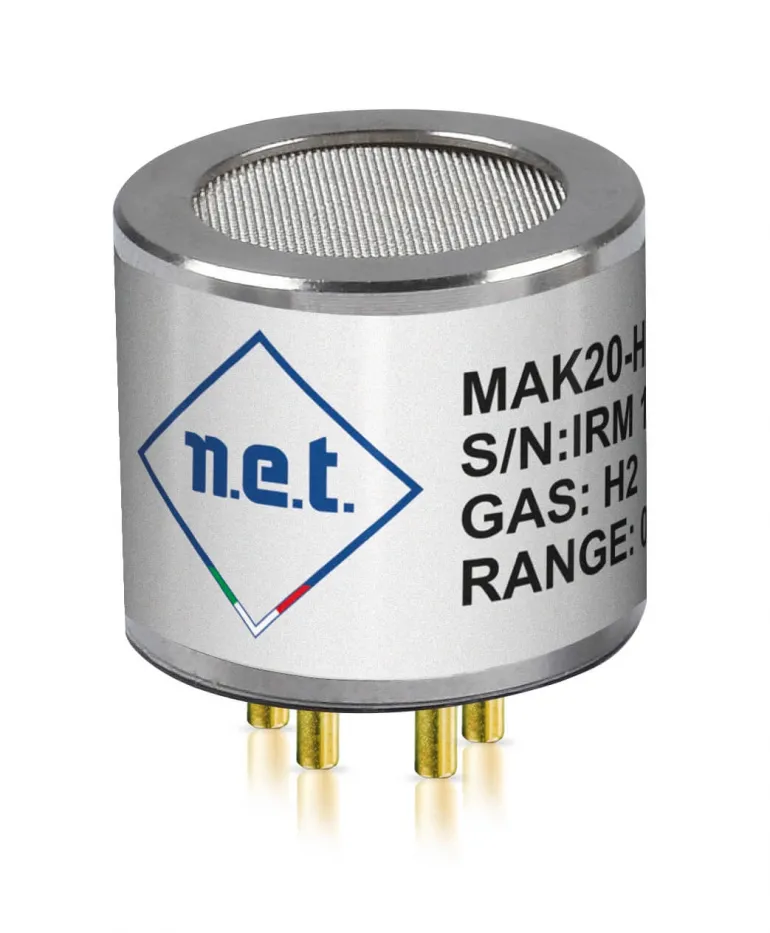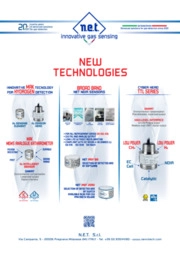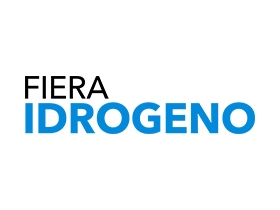NET MAK. Sensors and the Hydrogen economy
NET has developed the MAK (MEMS Analogue Katharometer) series of sensors. A thermal conductivity gas sensor, also known as a katharometer, measure the concentration of gases having thermal conductivity significantly different to a reference gas (normally, air), between 0 and 100% volume.
The Hydrogen economy is upon us. More and more, in the upcoming future, hydrogen will be used to decarbonize entire economic sectors, from heavy industry to natural gas substitute in gas grids, to fuel cells as alternative to internal combustion and electric batteries. A global sustainability effort is undergoing to significantly increase use of hydrogen between here and 2050.
Hydrogen is highly energetic and extremely environment friendly: it can be created from water using renewable sources such as wind and solar, and its combustion only releases water vapor into the atmosphere. Several technical challenges will undoubtedly have to be overcome to guarantee a large-scale use, such as storage, distribution and efficient engine technology.
Even when those challenges are met and surpassed, hydrogen will still remain one of the most explosive and oxygen-reacting gases known to man, combusting at even low concentrations, and safety will remain a concern. Hydrogen is colorless, odorless and tasteless therefore, the availability of reliable and selective detection technologies will become vital for a safe transition into a true hydrogen economy.
So far, the main technologies used in the safety industry for hydrogen detection are electrochemical and catalytic. Electrochemical cells cannot detect hydrogen in flammable ranges, working only up to a few percents in volume, while catalytic sensors function exclusively in the flammable range and in presence of oxygen - plus it reacts equally to any flammable gas mixture being therefore not very selective. Both technologies suffer significantly from drift, aging and, in some cases, poisoning, consequently requiring frequent maintenance and substitution to remain reliable.
With this in mind, NET has developed the MAK (MEMS Analogue Katharometer) series of sensors. A thermal conductivity gas sensor, also known as a katharometer, measure the concentration of gases having thermal conductivity significantly different to a reference gas (normally, air), between 0 and 100% volume. Thermal conductivity sensors are most effective when detecting gases with low molecular weight, which correspond to greater thermal conductivity - such as Hydrogen, possessing possesses the highest thermal conductivity of all known gases.
MAK Thermal conductivity sensors, unlike catalytic bead sensors, covers the broadest range of detection, working well from ppm level, up until 100 % volume. This is because they can operate without the presence of Oxygen.
MAK Thermal conductivity sensors provides far better long-term stability than sensors that are triggered by chemical reactions that eventually cause the sensor to degrade, such as electrochemical and catalytic. Thermal conductivity gas sensors, in fact, do not involve physical or chemical changes in the sensor. This, coupled with outstanding resistance to poisoning, results in far greater operating lives than for traditional technologies.
NET MEMS membrane-based sensor offers a far greater resistance to mechanical shocks when compared to traditional catalytic or thermal conductivity sensors.
For safe operation and to minimize power consumption, the sensor is excited with a pulsed waveform (400 ms on and 1,000 ms off), resulting in a heater temperature that is almost the same as the ambient.
Another key factor is the fast response time of the sensor (< 1.4 s), the only limiting factor being the time required for changes in the measurement resistor.
The world may not be ready yet for the transition to the Hydrogen Economy, but NET is - with the new MAK series of sensors.
Examples of applications where detection may be required:
- Hydrogen refueling stations.
- Electrolyser plants (producing hydrogen, separating it from water and producing oxygen as a result).
- Hydrogen storage vessels/cylinders
- Hydrogen test facilities
- Hydrogen vehicle deposits
- Battery storage rooms
- Hydrogen Pipelines
Hydrogen is highly energetic and extremely environment friendly: it can be created from water using renewable sources such as wind and solar, and its combustion only releases water vapor into the atmosphere. Several technical challenges will undoubtedly have to be overcome to guarantee a large-scale use, such as storage, distribution and efficient engine technology.
Even when those challenges are met and surpassed, hydrogen will still remain one of the most explosive and oxygen-reacting gases known to man, combusting at even low concentrations, and safety will remain a concern. Hydrogen is colorless, odorless and tasteless therefore, the availability of reliable and selective detection technologies will become vital for a safe transition into a true hydrogen economy.
So far, the main technologies used in the safety industry for hydrogen detection are electrochemical and catalytic. Electrochemical cells cannot detect hydrogen in flammable ranges, working only up to a few percents in volume, while catalytic sensors function exclusively in the flammable range and in presence of oxygen - plus it reacts equally to any flammable gas mixture being therefore not very selective. Both technologies suffer significantly from drift, aging and, in some cases, poisoning, consequently requiring frequent maintenance and substitution to remain reliable.
With this in mind, NET has developed the MAK (MEMS Analogue Katharometer) series of sensors. A thermal conductivity gas sensor, also known as a katharometer, measure the concentration of gases having thermal conductivity significantly different to a reference gas (normally, air), between 0 and 100% volume. Thermal conductivity sensors are most effective when detecting gases with low molecular weight, which correspond to greater thermal conductivity - such as Hydrogen, possessing possesses the highest thermal conductivity of all known gases.
MAK Thermal conductivity sensors, unlike catalytic bead sensors, covers the broadest range of detection, working well from ppm level, up until 100 % volume. This is because they can operate without the presence of Oxygen.
MAK Thermal conductivity sensors provides far better long-term stability than sensors that are triggered by chemical reactions that eventually cause the sensor to degrade, such as electrochemical and catalytic. Thermal conductivity gas sensors, in fact, do not involve physical or chemical changes in the sensor. This, coupled with outstanding resistance to poisoning, results in far greater operating lives than for traditional technologies.
NET MEMS membrane-based sensor offers a far greater resistance to mechanical shocks when compared to traditional catalytic or thermal conductivity sensors.
For safe operation and to minimize power consumption, the sensor is excited with a pulsed waveform (400 ms on and 1,000 ms off), resulting in a heater temperature that is almost the same as the ambient.
Another key factor is the fast response time of the sensor (< 1.4 s), the only limiting factor being the time required for changes in the measurement resistor.
The world may not be ready yet for the transition to the Hydrogen Economy, but NET is - with the new MAK series of sensors.
Examples of applications where detection may be required:
- Hydrogen refueling stations.
- Electrolyser plants (producing hydrogen, separating it from water and producing oxygen as a result).
- Hydrogen storage vessels/cylinders
- Hydrogen test facilities
- Hydrogen vehicle deposits
- Battery storage rooms
- Hydrogen Pipelines
Parole chiave: Idrogeno
- Paolo Di Marco
- EP Misura e Automazione
- Elisabetta Salata
- Giuseppe Grassi
- Paolo Di Marco
 English
English






















